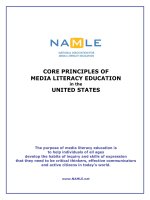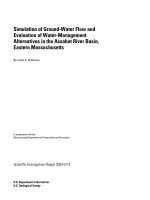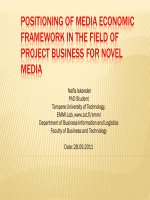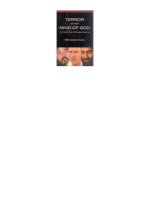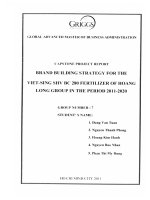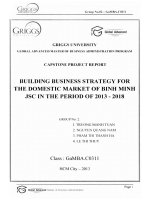Language and literature''s identity 1 of East Asian countries in “Chinese character cultural sphere” in the ancient and middle ages
Bạn đang xem bản rút gọn của tài liệu. Xem và tải ngay bản đầy đủ của tài liệu tại đây (1 MB, 11 trang )
TRƯỜNG ĐẠI HỌC SƯ PHẠM TP HỒ CHÍ MINH
TẠP CHÍ KHOA HỌC
HO CHI MINH CITY UNIVERSITY OF EDUCATION
JOURNAL OF SCIENCE
KHOA HỌC XÃ HỘI VÀ NHÂN VĂN
SOCIAL SCIENCES AND HUMANITIES
ISSN:
1859-3100 Tập 16, Số 7 (2019): 15-25
Vol. 16, No. 7 (2019): 15-25
Email: ; Website:
Research Article
LANGUAGE AND LITERATURE'S IDENTITY 1
OF EAST ASIAN COUNTRIES IN “CHINESE CHARACTER CULTURAL SPHERE”
IN THE ANCIENT AND MIDDLE AGES
Phan Thu Van
Ho Chi Minh City University of Education
Corresponding author: Phan Thu Van – Email:
Received: April 18, 2019; Revised: May 21, 2019; Accepted: June 10, 2019
ABSTRACT
Korean, Japanese and Vietnamese literature all used Chinese characters, received Chinese
literary influence, and tried to create national writing based on Chinese characters' application. In
this article, I will delve into the issue of influential language, literature and literary genres within
the Chinese character cultural sphere, while also detailing the specific nature and temperament of
the developmental process in regards to each country's literature.
Keywords: identity, East Asean literature, Chinese character cultural sphere (漢字文化圈).
1.
Introduction
Chinese characters are the root of Han culture and are considered the fifth largest
invention of the Chinese nation. The four oldest types of scripts that have ever appeared in
the world are: the Egyptian script, the Sumerian script, the Babylonian script and the
Chinese script, but only Chinese characters are still alive today, all the others are now dead
languages. Chinese characters are used not only in China, but together with Chinese
culture, crossing borders to neighboring countries, forming the “Chinese character cultural
sphere”. This sphere has proven extremely influential in the development and proliferation
of the writing script and national literature of many countries. It is the goal of the article to
contribute to finding common and specific points in the correlation of character and
literature between China, Korea, Japan, and Vietnam – the most relevant countries of the
“Chinese character cultural sphere”.
2.
About “Chinese character cultural sphere” (漢字文化圈)
The Chinese character cultural sphere, also known as the “East Asian cultural
sphere”, “Confucian cultural sphere” or “Kanji cultural sphere”, refers to the specific
cultural region in East Asia and parts of Southeast Asia that have historically been
influenced by Chinese politics and culture and either used Chinese script in the past or
remain influenced by them today.
Cite this article as: Phan Thu Van (2019). Language and Literature's identity 1of East Asian countries in
“Chinese character cultural sphere” in the ancient and middle ages. Ho Chi Minh City University of Education
Journal of Science, 16(7), 15-25.
15
Tạp chí Khoa học Trường ĐHSP TPHCM
Tập 16, Số 7 (2019): 15-25
The “cultural circle/field”, which originated in German “kulturkreis”, was developed
in 1897 or 1898 by the German scientist Leo Viktor Frobenius (1873-1938). The Japanese
linguist called Kamei Takashi (龜井孝, 1912-1995) borrowed the phrase from the Gemans
to represent a term about the area of East Asia where the Chinese language was used in
ancient times, so it translated into “cultural sphere” 文化圈. “Kanji/ Hanzi cultural sphere”
漢字文化圈 from a geographical perspective can be called the East Asian cultural sphere
東亞文化圈, and the Japanese historian Nishijima Sadao (西嶋定生, 1919-1998),
professor emeritus at the University of Tokyo, was the first one to use this name in his
research.
Chen Liao (陳遼, 1931 – now) in his work Extraterritorial Chinese Novels in the
Chinese Character Culture Sphere 《漢字文化圈內的域外漢文小說》 has written that the
cultural area of Chinese characters has been expanded five times: the first expansion of the
Chinese character cultural sphere was the import of Chinese character culture into the
Korean peninsula (It is said that the Chinese text was transmitted to North Korea at the end
of the Shang Dynasty – about the 10th century BC); the second time was when the Chinese
character culture crossed the sea to Japan (around the 3rd century BC); the third time was
when Chinese characters were brought to Vietnam, Cambodia, Laos, Thailand, Burma, The
Philippines, Malaysia, Brunei and Indonesia, et. al.; for the fourth time, when the Chinese
people crossed the sea on long journeys and brought Chinese characters with them to
Europe and America; for the fifth time, the various periods including the sixties and
seventies of the twentieth century when writers and students of Macau, Hong Kong and
Taiwan went to Europe, America, Australia... and later in the eighties and nineties, when
mainland Chinese writers and students did the same.
Along with Chinese characters, ideological doctrines from mainland China were also
spread through Korea, Japan, Vietnam... et. al. These countries all had centuries of using
Chinese characters, imbued with many Chinese ideological doctrines, and composed literature
in Chinese characters, before switching to using their own entirely national scripts.
3.
Correlation between Chinese characters and Japanese, Korean and Vietnamese
characters
In term of scripts, it can be seen that there were four most shared characteristics of
Japan, Korea and Vietnam in the ancient and middle ages: firstly, they all adopted and used
Chinese characters as an official writing system; secondly, they used Chinese characters to
record their ethnic languages; next, they all created a new system of characters based on
Chinese characters and forming the period of “parallel” language; finally, the national
character systems were initially disregarded and considered “irregular” and secondary
compared to Chinese characters, before developing rapidly and making a great contribution
to their national literature.
Looking first at Korea, the use of Chinese characters to record important documents
occurred on the Korean peninsula in the Three Kingdoms period (57 BC – 668): In the first
16
Tạp chí Khoa học Trường ĐHSP TPHCM
Phan Thu Van
century, the Goguryeo used Chinese characters to compile 100 historical documents of
Yugi (《留記》), along with many other history books thereafter, showing a high level on
using Chinese characters. However, these books are mostly damaged or lost because of
historical volatility. After the Chinese characters were transmitted into the Korean
peninsula, the ancient Koreans used both the sound and the meaning of Chinese characters
as a way to record the national language, which is called “hyangchal” 향찰 (鄕 札).
Therefore, in terms of recording ethnic language, “hyangchal” of Korea (since the first
century AD) was the first born, compared to the Manyogana まんようがな (万葉仮名) the earliest Japanese phonetic writing system which borrowed from Chinese characters –
kanji (from the 5th century AD) and the Vietnamese script “chữ Nôm” (since around the
second century to the 10th century AD). In the mid-fifteenth century, Hunminjeongeum
훈민정음 (訓民正音, meaning accurate sound to guide people) was born during the reign
of King Sejong (世宗, reigned from 1418 to 1450) that gave Korean literature a completely
new twist. After many ups and downs, finally the phonetic character system that was
inspired by the shape of the Chinese characters became the Korean national language.
In early Japan, Chinese characters were regarded as “the sacred language of the
Buddha and Buddhist literature” (N.I. Konrat, 1999, p.24). Buddhist epitaphs were found
written in Chinese characters, as well as some decrees of the court, the famous law of 17
terms of Prince Shotoku (604), Taihō-ritsuryō (《大宝律令》) (702), verses in collections
of poems Kaifūsō (《懷風藻》) (751), two historical works Tennōki (《天皇記》), and
Koki (《古記》) of Prince Shotoku (620, but lost in 645), historical work Nihongi
(《日本紀》) (720) among others. At the end of the 7th century, Japanese people began to
find a way to use Chinese characters to write Japanese. The process of moving from no
written language to the creation of the writing system “Kana” is a process of learning,
imbuing, and transforming Chinese characters into intrinsic substance based on Japanese
language and cultural characteristics. “Kana” is Japan's own phonetic script created from
Chinese characters, used in parallel with Chinese characters. “Kana” 「仮名」, in Chinese
means “pretending/ fake name”, to distinguish it from the “real name” 「真名」 which
refers to the original Chinese language, which was written in different ways like
Manyogana, Hiragana, Katakana, etc... In the early period, many people still held the view
that only Chinese characters were worth learning for the upper class. In addition, ancient
Japan also distinguished the onode script (男手male writing) and nonnade (女手female
writing). The soft, flexible form of written Hiragana was considered the writing of women
and children, a kind of “vile” script. It remained that way until Kinotsurayuki (紀貫之), an
artist who lived in the 9th-10th century during the Heian period, along with other poets
under the reign of Daigo Tenno, selected the antiquated collection of poems Kokin
Wakashū (《古今和歌集》) and decided to use Hiragana to write the book's preface which
opened the “poetics” (歌論), expressed the value of these soft words, and established the
17
Tạp chí Khoa học Trường ĐHSP TPHCM
Tập 16, Số 7 (2019): 15-25
position of the national script. Later, Murasaki Shikibu's Genji monogatari
(《源氏物語》) as well as many other outstanding works written in Hiragana by other
excellent writers also helped this form of writing to spread widely and gradually take on a
more predominant role in literature and become an important writing system of Japan up
until today.
In Vietnam, Chinese characters were also used as official national texts for more than
ten centuries. Vietnamese “Chữ Nôm” is formed on the basis of borrowing parts and the
structure of Chinese characters. Although it was widely used by writers and there was even
a short period of time when it was placed in an important position (during the time of Ho
Quy Ly in the 15th century and the time of Quang Trung Nguyen Hue in the XVIII
century), it never reached the level of complete replacement of Chinese characters or
became unified in usage rules. By the twentieth century, Vietnam switched to using Latin
script and Chữ Nôm was gradually replaced.
4.
Correlation between Chinese literature and Japanese, Korean and Vietnamese
literature
Korean, Japanese and Vietnamese literature can all be divided into three major areas:
oral folklore, national language writing literature and Sino writing literature. From the time
the indigenous literature of each country was formed up until the nineteenth century, the
oral folklore provided the foundation and source of each literature. It was a fertile land
cultivating the national language writing literature and Sino writing literature. However,
Sino literature was the basis of the writing literature of all Japan, Korea and Vietnam. In
terms of the form of genres and content, Japanese, Korean and Vietnamese literature were
all influenced by Chinese literature, before gradually developing to their peaks which were
marked by great works that were full of national spirit.
For example, Japan's largest and most ancient poem collection, Man'yōshū (萬葉集),
was modeled after the form of the Shijing (《詩經》). Japanese long poems are also based
on the ancient yuefu (樂府) poem. In the Tang Dynasty, a lot of works of almost all of the
greatest Chinese poets were received and translated into Japanese. Japanese Sino poems
were strongly influenced by Li Bai 李白, Du Fu 杜甫, Wang Wei 王維, and especially Bai
Juyi 白居易. Even the Japanese novel Genji monogatari (《源氏物語》), talking about
the obsessive and profound love of men and women, was inspired by Song of Everlasting
Sorrow (《長恨歌》) of Bai Juyi. (Phan Thu Van, 2012, p. 41-52).
Examples of Japanese literature composed in Chinese characters have appeared in
writings by a very large number of authors and a large number of works. In the book The
overview of Sino literature's writers (《漢文學者縱覽》) which was published in 1979,
written by Nagasawa Kozo 長沢孝三 and edited by Nagasawa Kikuya 長沢规矩也, there
were a total of 4930 writers who composed in Chinese characters, materials about whose
life and work are still retained. This number is believed to be incomplete.
18
Tạp chí Khoa học Trường ĐHSP TPHCM
Phan Thu Van
The spread of Chinese characters also provided extremely favorable conditions for the
dissemination of Chinese literature in the Korean peninsula, and also opened up a
development space for Korean Sino literature. Song of the yellow bird (《黃鳥歌》황조가)
is the earliest Sino poem still preserved from the Korean peninsula. According to The history
of the Three Kingdoms 《三國史記》, this poem was composed by Yuri
瑠璃明王유리명왕 of Goguryeo in the 17th year BC. This is a four-letter poem, it has a
very similar style to ancient Chinese poetry with simple content and rustic words. Later,
“The poem Lonely Rock Mountain (영고석(詠孤石)) written by Jong Bop-sa
(정법사(定法師)), a Korean monk who studied abroad in China in the 6th century came to
be considered Korea's first 5 – letter poem and was compared to the poem Country blessings
(國祚) of Pháp Thuận (法順) – also considered the earliest record of Vietnamese Sino
poetry.” (Phan Thi Thu Hien, 2017, p. 84). In the following centuries, the cultural exchange
between ancient China and Korea became more and more developed. One of Shilla's top
poets, Choi Chi-won / 崔致遠 (857-?), at the age of 12 went to the Tang Dynasty to study
abroad, at the age of 18 passed the Tang's examination and was appointed to be an official
and later became a famous poet. (This case is comparable to Khuong Cong Phu 姜公輔 (731
- 805) of Vietnam, who met the requirements of the Tang Dynasty in 780, becoming the first
and only Annamese to ever become the Tang Dynasty 's Prime minister (during the reign of
King Dezong 唐德宗). This is also comparable to Abe no Nakamaro 阿倍仲麻吕/
阿倍仲麿 (698-770), the Japanese who lived in the Nara period and was sent to study in the
Tang Dynasty, participated in a doctorate examination, and was appointed as mandarin. He
lived in China 54 years, through the three generations of Emperor Xuanzong玄宗, Suzong
肅宗, Daizong 代宗, receiving a lot of praise). In Vietnam and Korea, Chinese literature
developed sustainably, constantly moving from one development milestone to another, and
every different period had its great authors, especially excellent Sino poets.
Influenced by Chinese literature, in various periods with different lengths, Korean,
Japanese and Vietnamese literature formed the “parallel” literature's phenomenon: the Sino
literature co-existing in parallel with indigenous literature. However, this phenomenon
ended in Japan quite early, while in Vietnam and Korea, it lasted until the twentieth
century, and the most prosperous period of both literatures in these two countries was from
the 17th to the 19th century. An “advantage” that helped Japan escape Chinese influence,
was that by the end of the 9th century, diplomatic relations with China were interrupted
and Japan no longer sent messengers to China. But this only took place after the
intensively learning and fully utilizing all that had been learned in the socio-cultural reality.
Meanwhile, the geographical position of Korea and Vietnam adjacent to China as well as
other historical conditions led to these two countries experiencing more direct and longterm effects. In order to illustrate more clearly the correlation of the 4 countries in terms of
literature, this article provides an overview as follows:
19
Tạp chí Khoa học Trường ĐHSP TPHCM
Tập 16, Số 7 (2019): 15-25
China
Japan
Korea
Vietnam
Before
8th
century
BC
Oral literature
The beginning of
Chinese characters. 2
– 3 – 4 word poetry
appeared.
Oral literature
Oral literature
Oral literature
8th- 3rd
century
BC
Pre-Qin prose.
China's first poetry
collection:
Shijing
(5th century BC)
2nd
century
BC
Historical
record/
Shiji 史記 Si Maqian
(2nd -1st century BC)
The formation of
yuefu 樂府.
Formation
and
development of fu賦,
also called Han fu
漢賦 (2nd BC – 3rd
AD)
Nineteen
ancient
poems 古詩十九首
(1st - 2nd AD)
1st
century
BC
1st
century
AD
1000 years Chinese
domination (111 BC –
905 AD)
Poetry
and
prose
composed in Chinese
characters began to
appear.
In the first century, the
Goguryeo
used
Chinese characters to
compile 100 historical
documents of Yugi
(《留記》)
2nd
century
3rd
century
4th
century
The formation of note
novels 筆記小說 Han
– Wei – Six Dynasties
漢- 魏 - 六朝
Baekje compiled the
history book called
Seogi
(서기
《書記》).
Hyangga 향가 was
born based on Korean
folk songs.
Hyanggog 향곡 was
born
based
on
traditional
Korean
music.
5th
century
6th
century
Formation
and
development of the
Palace's
poetry
宮體詩.
Baekje
National
《國史》
7th
century
The golden age of
poetry:
Tang
Goguryeo edited and
rewrote
Yugi
20
compiled
history
Tạp chí Khoa học Trường ĐHSP TPHCM
8th
century
poem唐詩.
Formation
and
development of the
Tang fu 唐賦.
Formation
and
development of the
Tang chuanqi/ Tang
Dynasty
stories
唐傳奇.
9th
century
10th
century
11th
century
12th
century
Phan Thu Van
(《留記》)
in
volumes 《新集》.
5
Records of ancient
events Kojiki (712)
The Chronicles of
Japan/ Nihongi (720).
Sino poems collection
Kaifūsō (751)
The oldest extant
collection of Japanese
waka/ Manyoshu (771)
Khuong Cong Phu
became the first
Vietnamese author in
history to have a fu (賦)
recorded, which has
been passed on to this
day, Bạch Vân chiếu
xuân hải
(《白雲照春海賦》).
The oldest extant
Japanese prose
narrative The tale of
the bamboo cutter/
Taketori - monogatari
(893?)
Formation
and
development of the
Song ci 宋詞 (10th 13th century)
Poetry
and
fu
continued to evolve
into a different genre
during this period.
Ise
–
monogatari
(931?) - Japanese uta
monogatari, or the
collection of waka
poems and associated
narratives, dating from
the Heian period.
The genre of diary
stories appeared with
Toka-niki (935), the
genre of Juihutsu
appeared
with
Makura-nososhi (936)
The special creation of
tanka
poetry
was
formed with the poetry
collection
Kokin
wakashu (950)
Appearance of the
genre “story-telling
person” / shuohua ren
說話人, also called
shuoshu ren 說書人.
From
this
basis,
storyteller's
script/
huaben 話本 and the
genre of huaben's
imitation began to The Japanese classical
novel, considered to be
form.
the world's first novel:
The tale of Genji/
Genji monogatari
(1010) was written.
Appearance of epic
accounts such as The
Tale of the Heike/
Heike – monogatari
(often likened to a
Japanese Iliad) , etc.
Appearance
of
Sarugaku and the
21
Due to the electoral
regime, literature of
Chinese
characters
developed
strongly,
playing a key role in
the literature of the
Goryeo period (918 1392).
Local lyrical poetry
from around the 11th
century to the 14th
century
became
collectively known as
Goryeo
sogyo,
changga or pyolgok.
The
genres
of
Gyeonggichega, Sijo
and Gasa were born in
the second half of the
Goryeo period.
The group of poets
called
해좌칠현
海左七賢 composing
in Chinese characters
in the middle of
Goryeo achieve high
achievement in terms
of Chinese poetry art.
The works of historical
stories
developed,
including the history
and unofficial history,
Vietnamese
independent literature
formed.
The literary heritage of
Chinese
characters
during the Ly - Tran
period was seen in a
variety of genres: Thiên
đô chiếu (1010), Dụ
chư tì tướng hịch văn,
Việt Điện u linh tập
(1329), Thiền uyển tập
anh ngữ lục, Bạch
Đằng giang phú, Ngọc
tỉnh liên phú v.v... In
addition, there were:
Đại Việt sử kí (1272),
Đại Việt sử lược (about
1377).
The earliest Nôm text
of the Trần Dynasty still
in existence remains Cư
trần lạc đạo by Trần
Nhân Tông, Vân Yên tự
phú by Zen master
Huyền Quang.
Tạp chí Khoa học Trường ĐHSP TPHCM
13th
century
Formation
and
development of the
Yuan
qu
元曲,
including sanqu散曲
and zaju雜劇.
14th
century
15th
century
16th
century
17th
century
Tập 16, Số 7 (2019): 15-25
storytellers Sarugaku – such as The history of
hoshi.
Three
Kingdoms
《三國史記》
(1145),
Formation of genres
A
Study
of
Silla
with
stage
Buddhism
in
the
Three
characteristics,
the
Stories
most typical were Kingdoms
kusemai and gengaku. 《三國遺事》 (1281).
Noh was performed
and developed.
The golden age of
Chinese the classical
novel, also called the
chapter
novel/
zhanghui
xiaoshuo
章回小說, Ming-Qing
fiction明清小說.
Originally, the chapter
novel
inherited
storyteller's
script,
with a focus on
historic narrative. At
the end of Yuan
Dynasty and early
Ming Dynasty, the
representative
classical
novel
appeared, e.g.: The
romance of the Three
kingdoms
《三國演義》, The
water
margin
《水滸傳》
v.v...
From the middle of
the Ming Dynasty's
onwards, the chapter
novels matured, with
Journey to the West
《西遊記》, Jin Ping
Mei 《金瓶梅》 etc.
Theatre continues to
develop, setting new
milestones, such as
The Peony pavillon
《牡丹亭》.
In the Qing Dynasty,
the chapter novel
continued to grow
steadily with works
like
Unofficial
History
of
the
Scholars
Appearance of joruri a type of sung
narrative
with
shamisen
accompaniment
and
Otogi-zoshi.
Haiku poetry formed
and developed.
Theatre developed to
its peak.
The novel continued to
evolve
with
the
monogatari
genre
writing about the life
of the people in the
cities.
22
In the mid-fifteenth
century,
Hunminjeongeum
훈민정음 was born
that
gave
Korean
literature a completely
new twist.
Poetic works became
musical
and
are
performed in early
Joseon court rituals,
creating the Akjang
genre.
The Hangeul novel
appeared along with
the Chinese translation
of the Ming novels into
Korean. Heroic novels,
sleepwalking novels,
nightlife novels and
family novels were
born in turn. Typical
works included: The
nine cloud dream
(구운몽《九雲夢》).
Chinese
literature
reached the period of
prosperity, the typical
work was Kum-OShin-Hwa (금오신화
金鰲新話).
Gajeon and allegorical
literature,
the
legendary
novels
flourished.
A collection focused
on writing Chinese
characters' works from
the time of Three
kingdoms to the time
of
Joseon
was
compiled in 1478
including 45 volumes,
Literature
developed
with rich genre systems.
The
greatest
achievement of the
prose
of
Chinese
characters in the period
of 15th - 17th century
were Thánh Tông di
thảo and Truyền kỳ mạn
lục.
Nôm literature appeared
in large collections,
such as Quốc âm thi tập
(254 poems), Hồng Đức
quốc âm thi tập (328
poems) et al during the
second half of the 15th
century creating “the
century of Nôm Tang
poetry”.
In the 16th and 17th
centuries, Nôm poetry
became the national
poetry reaching a large
scale, such as Lâm
tuyền
vãn
(185
sentences), Ngọa Long
Cương
vãn
(136
sentences), Tư Dung
vãn (332 sentences), the
historical long poem
Thiên Nam ngữ lục
(8136
sentences)
written in the form of
Vietnamese traditional
6-8 word poetry; Tứ
thời khúc vịnh (nearly
400 sentences), Thiên
Nam minh giám (938
sentences) written in
the form of Vietnamese
traditional “song that
luc bat” poetry.
Tạp chí Khoa học Trường ĐHSP TPHCM
18th
century
19th
century
《儒林外史》,
“Liaozhai” Strange
tales from a lonely
studio 《聊齋誌異》
etc.
Chapter
novels
developed to their
peak
with
the
masterpiece
Hong
lou meng/ The dream
of
red
mansions
《紅樓夢》.
Phan Thu Van
and 133 books.
Drama mask dance
from the countryside
(which originated from
agricultural
rituals)
gradually moved into
the city.
The pansori novel was
born based on the
famous
works
of
traditional
singing
pansori in folklore, the
most
representative
work is The story of
Chunhyang
(춘향전
春香傳).
The 18th century and
the first half of 19th
century
was
“The
golden
age”
of
medieval Vietnamese
literature.
Nom
literature
flourished with the
following
categories:
Nom Tang poetry, 6-8
word poetry, form of
“song that luc bat”
poetry and vocal poetry,
creating the culmination
of national literature,
such as Hồ Xuân
Shintaishi (新體詩, or The genre of Japga Hương's poems and
of
12 Truyện Kiều, Chinh phụ
“new poetry”) became consisting
a counterweight to the different types appears. ngâm khúc, Cung oán
ancient forms of
ngâm khúc, etc.
ancient waka and
haiku.
Of course, briefly generalizing all four literatures is an impossible task, because it is
impossible to frame the lively development of literature on any graphical tables alone.
However, we tried to show the main events and highlights in the development of the genres
in each literature. Using this method, it is not difficult to realize that: Chinese literature
perfected poetry before perfecting the novel, while Japanese literature flourished in novels
before mastering poetry. Meanwhile, Korean literature did not separate poetry from music
throughout its development process, and Vietnamese literature reached its most prosperous
stage by combining poetry and novels into a single genre. This may partly prove the
problem of literary identity. We know that at the beginning of human literature, poetry was
born from the process of labor, and was always associated with melody, but after that,
music and poetry gradually separated. In Kojiki and Nihongi, the melodies existed under
the presenting of sound, whereas the poems in Manyoshu were very different: “What made
Manyoshu's poems poetry, were not their melodies, but more melodic laws and the laws
that still organize the tone of human voices including the rules of rhythm and its activity
related to rhythm. These are not songs but verses that were written to be read.” (N.I Konrat,
1999, p. 34). The separation from melodies of Japanese literature was probably due to the
strong, rational thinking and the intrinsically calm nature of this literature, which led to the
creation of novels as a “unique” historical phenomenon: “As we know from the history of
world literature, in the majority of the peoples present on the historical stage in the middle of
the century, the prose of the story begins from the epic - from the miraculous story to the long
poems. Japanese storytelling literature also originated from miraculous stories but it quickly
evolved, skipping the epic songs and going straight into novels.” (N.I Konrat, 1999, p. 52)
23
Tạp chí Khoa học Trường ĐHSP TPHCM
Tập 16, Số 7 (2019): 15-25
Unlike Japan, the earliest poetry in the Korean peninsula was ancient folk song
combined with music and dance. During the Three Kingdoms (5th century to the 10th
century), Korean national poetry developed a new form of “rural song” based on a folk
song, and this “song” took Korean traditional music as its basis. The word “hyang” (means
“rural”鄉) in “hyangga 향가” (鄉歌) and Hyanggog 향곡 (鄉曲) means what belongs to
indigenous people, as a way to distinguish itself from Tang's song and Tang's poetry. In
Korean literature, lyrical folk songs, national language poetry and the “pansori” versions
were all for singing, rather than for reading, and the music has never been truly separated
from indigenous literature. Since then, one of the greatest achievements of Korean
literature, pansori novels, with the representative of Xuan Huong story, is a combination of
music, theatre and literature. This also contributes to explaining one of the contemporary
cultural phenomenons, whereby Korean movies today are gaining worldwide attention and
popularity, in a way that cannot be separated from their literary origins.
Considering the specific nature and temperament of each literature, it can be seen
that despite being in the cultural sphere of Chinese characters, Japan and Korea are
“antipodal” because the core spirit of Japanese literature is a subtle quietness, while the
core spirit of Korean literature is a straight vividness. In this aspect, China and Vietnam
also show that their ethnicity is completely different, because Chinese literature is imbued
with quiet contemplation, while Vietnamese literature is full of anxiousness. At the same
time, Chinese literature is always cumulative, while Vietnamese literature tends to be
scattered. It can be seen that to understand Japanese literature, one must have a calm mind;
in order to understand Korean literature, one must have a sense of music; in order to
understand Chinese literature, one must have a historical thinking ability; in order to
understand Vietnamese literature, one must have a poetic soul. Within the narrow scope of
this paper, we cannot prove arguments. However, these are completely scientific
conclusions, and we will continue to improve on them in subsequent studies.
5.
Conclusion
Korean, Japanese and Vietnamese literature all used Chinese characters, received
Chinese literary influence, and tried to create national writing based on Chinese
characters' application. Language is the outer shell of thought, while language
dependency is also ideological dependence. So the efforts to localize Chinese characters
and the creation of ethnic writing were also efforts to “escape Chinese influence”. On the
basis of the development and perfection of the language and literature, each country
experienced “parallel” stages of development, followed by breakthrough efforts involving
the formation of the national literature to create their own mark in history.
Conflict of Interest: Author have no conflict of interest to declare.
24
Tạp chí Khoa học Trường ĐHSP TPHCM
Phan Thu Van
REFERENCES
N. I. Konrat. (translated by Trinh Ba Dinh). (1999). Japanese literature from ancient to early –
modern period. Da Nang Publishing House.
Phan Thi Thu Hien. (2017). Korean classical literature – Progress and identity. Social science
publishing house.
Phan Thu Van. (2012). Chinese cultural factors in “Genji monogatari” and their literary
significance. Ho Chi Minh City University of Education Journal of Science (Social Sciences
and Humanities), 38(72), 41-52.
MỘT SỐ VẤN ĐỀ VỀ BẢN SẮC NGÔN NGỮ VÀ VĂN HỌC
CỦA CÁC QUỐC GIA ĐÔNG Á TRONG “VÒNG VĂN HÓA CHỮ HÁN”
THỜI CỔ TRUNG ĐẠI
Phan Thu Vân
Trường Đại học Sư phạm Thành phố Hồ Chí Minh
Tác giả liên hệ: Phan Thu Van – Email:
Ngày nhận bài: 18-4-2019; ngày nhận bài sửa: 21-5-2019; ngày duyệt đăng: 10-6-2019
TÓM TẮT
Văn học Triều Tiên, Nhật Bản và Việt Nam cùng sử dụng chữ Hán và tiếp nhận ảnh hưởng
văn học Trung Hoa, đồng thời đều có ý thức sáng tạo chữ viết dân tộc và ứng dụng trên nền tảng
chữ Hán. Trong phạm vi hẹp của bài nghiên cứu, chúng tôi sẽ đi vào vấn đề ảnh hưởng văn tự, văn
học và thể loại văn học của các quốc gia tiêu biểu trong vòng văn hóa chữ Hán, đồng thời chỉ ra
điểm riêng về tính chất và khí chất trong quá trình phát triển của mỗi nền văn học.
Từ khóa: bản sắc, văn học Đông Á, vòng văn hóa chữ Hán.
25


